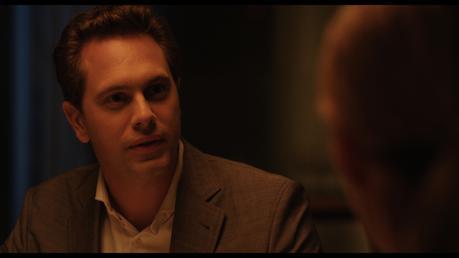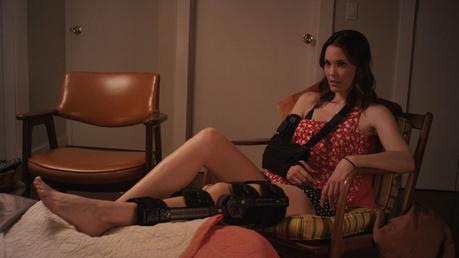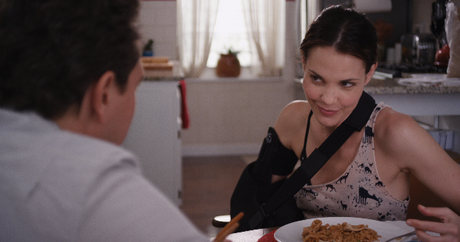Take Care is a 2014 comedy-drama hybrid about a woman (Leslie Bibb) who guilts her ex-boyfriend (Thomas Sadoski) into taking care of her as she recovers from car crash-related injuries. He wants to say no, but he may kind of owe it to her since she spent a year helping him get through cancer at which point he dumped her. It is the debut feature for writer-director Liz Tuccillo, a former Sex and the City writer best known as the co-author of He’s Just Not That Into You. It completely slipped under my radar until Netflix’s version of the “If you liked this movie, you might like these other ones” recommendation recently brought it to my attention. Because I watched Josh Radnor’s rom-com Liberal Arts I was told I might also like Take Care along with several other low-profile comedies, many of which star TV actors, like Community’s Alison Brie in Save the Date, Reaper’s Tyler Labine in Best Man Down, The Office’s Jenna Fischer in The Giant Mechanical Man, or Mad Men’s Jessica Pare in Standby. Coincidentally, Take Care’s stars have also done their time on TV, Leslie Bibb in Popular, Crossing Jordan, CGB, and About a Boy, and Thomas Sadoski in The Newsroom and currently The Slap. However, because I am often preoccupied with the business side of filmmaking I sometimes wonder where all of these films come from, so many of them with fairly basic movie posters, looking every bit the part of an indie comedy. So, this is the story of how Take Care ended up on Netflix. Well, kind of. I’m not exactly privy to contract negotiations or anything like that.
Two or three decades ago, something like Take Care or any of those other mentioned comedies would have likely been made within the studio system for as much as $30 million, qualifying as a mid budget release. However, as Steven Soderbergh (Sex Lies, and Videotapes, Traffic, Oceans 11, Magic Mike) made perfectly clear in his keynote address at the 2013 San Francisco International Film Festival the mid budget studio film is dead. As he described it, more movies are coming out now than ever before (677 in 2013 versus 455 in 2003), but more and more of those are micro-budget independents (100% increase from ’03 to ’13) and fewer and fewer are studio films (28% decrease across the same time span). That would maybe be a good thing, but studio films have gone from a 69% market share to 76% meaning fewer studio movies are taking up more of the market while twice as many independent films are left fighting for what’s left.
As a result, the film industry has become increasingly polarized between big budget tentpoles based on pre-existing intellectual properties (YA novels, comic books, Disney princesses) and micro-budget indies. Mid budget 2015 bombs like The Gunman and Run All Night aren’t helping the cause, and a similarly-budgeted hit like Fifty Shades of Grey is more of an additional argument for the benefit of championing pre-existing properties. Benaroya Pictures, the production company behind recent mid-budget fare like Lawless, The Paperboy and Kill Your Darlings, recently shut down production on two separate films despite the involvement of recognizable talent like Robert De Niro, Bruce Willis, and Robert Pattinson, suggesting Benaroya is not long for this world. Elsewhere, a Chinese backer has partnered with an upstart US studio named STX to spend nearly $3 billion across the next three years to primarily produce mid-budget ($20m-$80m) films, but Hollywood insiders have mostly thrown up a “I’ll believe it when I see it” reaction.

Thomas Sadoski attempting to break the news to his current girlfriend
Where does all of this leave something like Take Care? In another era, this could finally be Leslie Bibb’s breakthrough comedy. She’s been on TV shows, played Will Ferrell’s fickle wife in Talladega Nights, and screwed Tony Stark in the first Iron Man, possibly still the only sex scene in the Marvel Cinematic Universe. But she’s never had a While You Were Waiting like Sandra Bullock. The studios aren’t interested in making that kind of movie anymore. As Selma’s black female director Ava DuVernay put it, “The bottom line is that it is not their current business model. So, do you not do it? Do you not make your film? What do you? You find another model. You find another way to do it. If you’re waiting around for someone else to change their mind in order for you to speak your mind you’re going to be waiting a long time.”
Bibb and Liz Tuccillo found another way, partnering as producers on Take Care and collaborating during the casting stage right up to the editing process. They filmed over 19 days in New York, working with a mostly female crew. The actual idea for the film came from Tuccillo, who was inspired by a friend’s experience recovering from rotator cuff surgery, another friend’s story about being in a car accident, and a boyfriend who had cancer many years before they were together. She also drew from her years working in the Sex and the City writer’s room, whose naturally cramped quarters fostered camaraderie as well as conflict. As such, Take Care often limits its setting to the modest New York walk-up apartment-turned-temporary prison for Bibb’s character as she recovers from a broken arm and leg. Of course, you also limit your setting like that because you probably didn’t have a lot of money to film in a bunch of other places.

Leslie Bibb in her apartment
The setting is utilized for immediate comedy in the opening scene in which Bibb’s sister (Nadia Dajani) and friend (Marin Ireland) escort her home from the hospital and immediately realize they have no idea how they’ll get her up the stairs and in her apartment. However, it also works to enhance the drama once Sadoski’s Devon comes along to take care of Bibb’s character, whose friends and family are either too flaky or busy. This is where the film either succeeds or fails for you: are you willing to go along with liking Bibb’s character for manipulating her ex into helping her even though she does have actually have other, albeit less reliable options? Is she actually entitled to her bitterness towards her ex for dumping her, and does he actually kind of owe it to her? I went along with it, thinking that he did in fact owe it to her. It’s an obviously contrived scenario, but it does effectively force the ex-lovers to actually talk through their emotions and come to a better understanding of why they broke up. Bibb and Sadoski have a natural, enjoyable chemistry together, with Bibb going mostly makeup free throughout and calling upon her inner-goofiness to sell most of the comedy.
In a different era, this story would likely be told beginning with a depiction of the car wreck, probably following Bibb as a busy gal of the city, bustling from one local to another, all set to some pop song offering ironic commentary. Devon would be seen at his job, likely with a comic relief best friend who has plenty of sex-related one-liners about being forced to act as your ex-girlfriend’s slave while keeping it a secret from the new girlfriend, who would be depicted in a mostly negative light. Oh, and Bibb would have to have a sassy gay friend. There’d probably be some farcical scene involving several people entering and exiting Bibb’s apartment as she comically attempts to move around despite her injuries.
Of course, Take Care does have several of those things. Bibb does indeed have a sassy gay friend, but sparingly. Devon does have a new girlfriend who is probably not right for him, but Nurse Betty’s Betty Gilpin makes her likable. The movie points out that she’s completely right to think the entire situation with her boyfriend taking care of his ex his not normal, thus making her related insecurity understandable. And the two big comedy set pieces do involve people entering and exiting the apartment as an immobilized Bibb attempts to move in response. But it’s just so New York indie film of them to minimize the rom-com goofiness and mostly give us two people hanging out in an apartment together, watching and joking about Law & Order and growing increasingly comfortable enough to broach big topics like cancer.

Sadoski and Bibb. We do see her kitchen from time to time.
That does present obvious limitations. Take Care might make for a better play than film as nothing about it seems particularly cinematic. Plus, it doesn’t feel like it completely earns what becomes of the central characters.
It’s for all of those reasons that when Take Care premiered at SXSW in early 2014 it received middling reviews. THR, for one, concluded, “Take Care features some amusing moments, to be sure. But we’re never invested in its characters’ fates, and its surfeit of sitcom-style cliches, including the presence of the inevitable flamboyantly gay best friend (Kevin Curtis), makes it seem far more suitable for the small screen.” That’s how you go from premiering at a film festival to waiting for 5 months to finally get a distribution deal. One Film Entertainment finally picked them up in August 2014, joining the New York-based indie distributor’s recent slate of acquisitions like Two Night Stand, starring Miles Teller and Analeigh Tipton; the Ryan Phillippe thriller Catch Hell and the dark Katie Holmes comedy Miss Meadows. All of those films ended up playing in just a handful of theaters, 5 in the case of Two Night Stand. Take Care made it into theaters and onto VOD in December, and by April of 2015 it’s already on Netflix and playing in regular rotation on one of Showtime’s channels.
Liz Tuccillo has already moved on, optioning her novel How to Be Single about the lives of several single New Yorkers. It will now be a movie directed and written by other people and starring a kind of awesome cast consisting of Dakota Johnson, Alison Brie, Lily Collins, Dan Stevens, Rebel Wilson, Leslie Mann, and Daman Wayans, Jr. It’s actually set up at New Line Cinema. Leslie Bibb has completed one movie (Don Verdean) and appeared on several sitcoms, About a Boy and The Odd Couple, since Take Care. As of late last year, she was contemplating following Reese Witherspoon’s example and pursuing a producing career to generate more of the types of roles she’d like to play as well as ones she’d simply like to watch as a film fan, “I like taking somebody’s idea, or story, or fantasy about what they want to do and helping make that a reality. That’s a cool thing for me.”
And that’s how Take Care went from being a simple idea a New York writer had to a film Netflix told me I might like. Part of the reason I highlighted its production history rather than merely write a traditional review is to make more sense of how some of these movies end up on Netflix. However, it’s also to battle the argument there are no good romantic comedies out there anymore or whatever other genre of film Hollywood studios now ignores. There are tons of them! They’re just not really making it into theaters, and they’re being made for far cheaper. Take Care is not perfect, and much of my enjoyment is tied to my inability to find Bibb as anything other than utterly charming. However, if movies you watch on Netflix are graded on a curve then Take Care definitely passes the “Is it worth streaming for free?” test.
Second Opinions
TheDissolve: “Take Care could have been great, if only it were any good at all. A film about an injured young woman who convinces her ex-boyfriend to be her primary caregiver had every prognosis to emerge as a romantic comedy for the age of Obamacare, something to combine the vulnerability of the body with the twinned messiness of recovery and relationships. But the movie is dreadful, filled with painfully broad humor, grating performances, and acidly rendered characters.”
IndieWire: “Perhaps unsurprising, given Tuccillo’s roots on the small screen, that “Take Care” feels like it would be more at home if it skipped theaters entirely. It would make more sense as a TV movie or a direct-to-iTunes offering. It’s not bad, but it’s not worth leaving your house for—even if you have use of all your limbs.”

